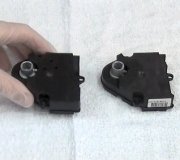1st type: vibration in steering wheel when it is static and in gear (Drive mode). In neutral, it has very little vibration.
2nd type: when it is moving, I have vibration at 65Mph - 85 Mph and above. The vibration is both when in 'Drive' mode as well as when coasting in neutral. This vibration started when the car climbed over a roadside curb (only the front, driver side wheel hit the curb and bent the rim).
I have replaced the rim with new rim, also added new tire to it and also balanced the wheel.
Please let me know how to fix both the types of vibrations
What I have done so far:
I have replaced the front driver side wheel (damaged) rim and tire with new ones. I have also added new tire (same brand, same make) to the front passenger side. Both the front wheels are balanced. Both the rear tires are still old and not (newly) balanced. I will soon replace the rear tires as well with new ones (and also balance them).
For the static vibration issue, I tried to examine the engine mounts with a flash light, and they looked ok and with no cracks.
For the moving vibration issue, I set up the front driver side wheel on jack and tried to manually move/shake the wheel with my hand thinking the CV joint must have failed because of the impact to the curb. The wheel felt firm and ok.
Please advise
Tuesday, May 31st, 2011 AT 4:45 AM


